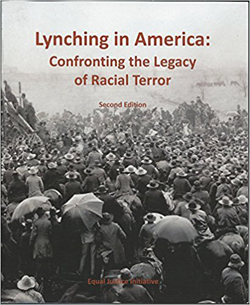 Lynching in America: Confronting the Legacy of Racial Terror (Montgomery: The Equal Justice Initiative, 2017 third edition), available online at eji.org.
Lynching in America: Confronting the Legacy of Racial Terror (Montgomery: The Equal Justice Initiative, 2017 third edition), available online at eji.org.
On April 26, 2018, the National Memorial for Peace and Justice opened in downtown Montgomery, Alabama, on a six acre site near the state capital where American slaves were formerly auctioned for market. Informally known as the "Lynching Memorial," the outdoor exhibit commemorates the more than 4,400 documented victims of "racial terror" that were concentrated in 12 southern states from 1877 to 1950. On the same day, and near the memorial, the Legacy Museum: From Enslavement to Mass Incarceration also opened. The $20 million complex was paid for by private funds, and was the brainchild of Bryan Stevenson, the Harvard-trained attorney, founder of the Equal Justice Initiative, and author of the best-selling book Just Mercy.
First published in 2015, this report by the EJI, which includes 351 footnotes and numerous archival photographs, documents its comprehensive historical investigation of lynching in America. The newly opened National Memorial and Legacy Museum fulfill the report's challenge to move beyond the complicity of silence about the barbaric, sadistic, and systemic violence in our nation's history.
Lynching was not just a form of punishment, vigilante justice, or isolated hate crimes. Rather, lynching was a carefully calculated and comprehensively executed form of racial domination and terror. The lynchings were often accompanied by burning, torture, mutilation, dismemberment, and decapitation that were not just forms of crime control, as was often claimed, but means of racial control. The report explains how this violent history has shaped virtually every aspect of African American life today — geographical, political, social, educational, and economic. Worse yet, the report draws a direct line from the history of lynching to its contemporary iteration in our criminal justice system today that has become "the central institution for sustaining racial domination and hierarchy in America" — mass incarceration, rates of capital punishment, and police abuses.
Some lynchings were done in isolated and remote areas by psychopaths. But they were also and often carefully choreographed public events and spectacles that were advertised, described by lurid media headlines ("colored man roasted alive"), and attended by thousands of voyeuristic spectators. They were carried out by and celebrated by leading citizens, state and federal congressmen, and leaders in business and church. "Our American Christians," wrote the anti-lynching activist Ida B. Wells, "are too busy saving the souls of white Christians from burning in hell-fire to save the lives of black ones from present burning in fires kindled by white Christians." There was no due process of law in most of these lynchings, nor any attempt to hide the identity of the executioners. The US postal service was happy to mail commemorative post cards with pictures of lynchings. Trains provided free services to the spectacles. Yes, there were lone dissenting voices, but far too few.
Although the north won the Civil War, the report argues, the south won the narrative war about racial inequality and domination that still haunts us today. Consider, for example, the many hundreds or thousands of public buildings and monuments that celebrate the racist South and the Confederacy, and the precious few memorials to the history of lynching or to the many brave and articulate activists like Ida B. Wells. Until we publicly acknowledge this legacy of racial terror, as has been done with the Berlin Holocaust Memorial and the Apartheid Museum in Johannesburg, true progress and healing will be very difficult indeed. For more on this subject, see my book review of Without Sanctuary; Lynching Photography in America (2000).


